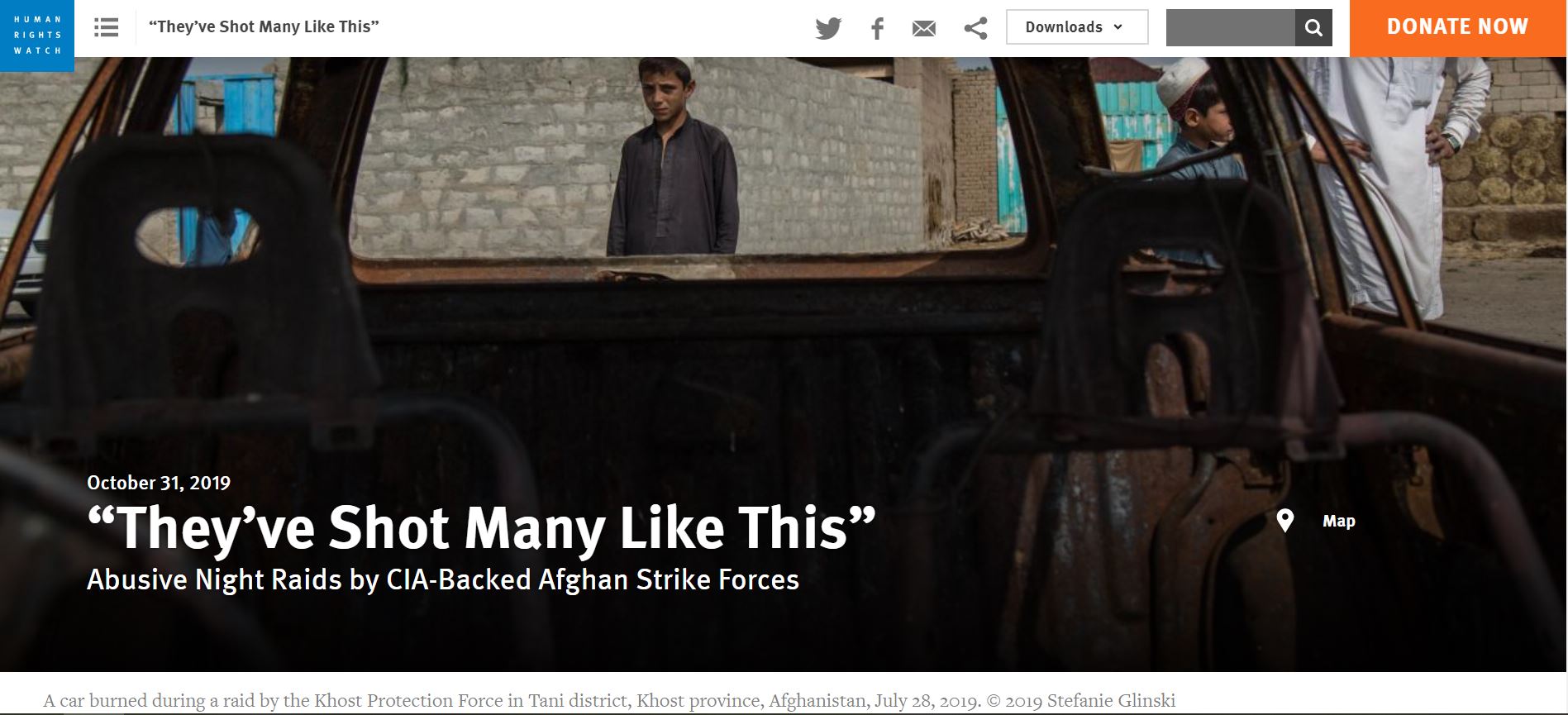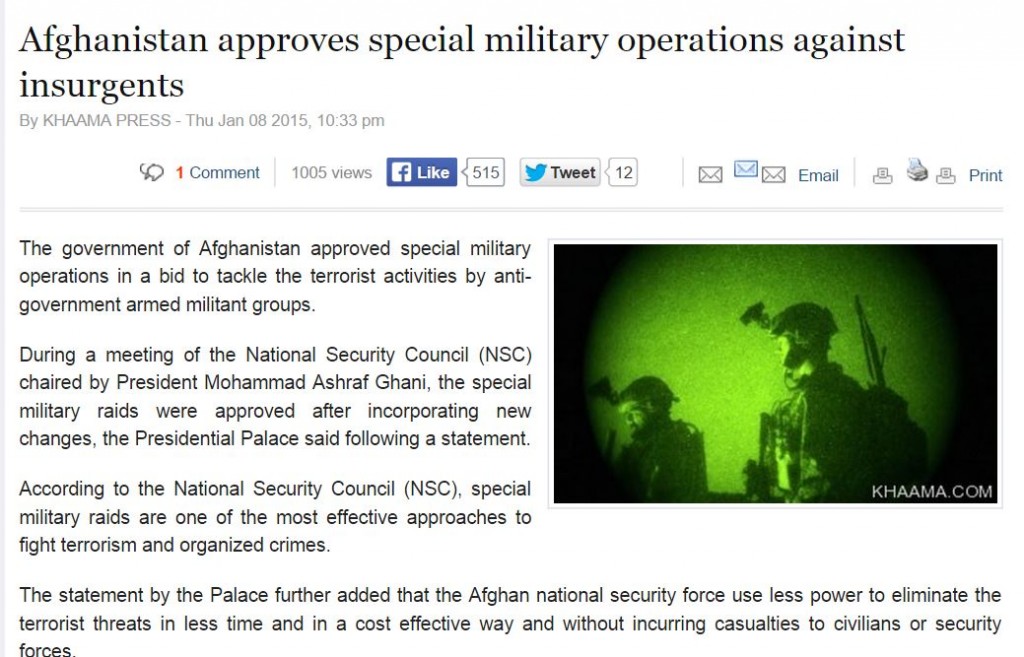Meanwhile, The Pace Of US War Crimes In Afghanistan Accelerates Dramatically
Jim here.
Some of you might remember that long ago, I used to blog nearly daily on the never-ending US military misadventures in Afghanistan and Iraq. The issues of torture, night raids, death squads, secret prisons, and then drones all made it obvious to anyone who was paying attention that the senseless crimes carried out under cover of the US “war effort” were creating new enemies faster than our forces were removing them from the battlefield. Spencer Ackerman today noted a new report from Human Rights Watch that gave me a serious flashback to the days of following those issues closely. What I saw there was jarring. It is clear that under Trump, what Obama had tried to pretty up and hide (even though it still went on) came back into more openness than at any time. Human Rights Watch pulls no punches in labeling many of the things they found as war crimes.
In a post nearly ten years ago, I noted, as usual, that things in Afghanistan were going poorly. That post, as I’m sure many of my posts around that time did, linked to one of the most seminal pieces of work describing what was really going on in the war effort their under the Obama Administration: Anand Gopal’s piece describing how the night raids that played such a crucial role in McChrystal’s COIN programs in both Iraq and Afghanistan were hidden by moving them to raiding parties comprised of Special Operations forces often supplemented with private, CIA-trained militias:
The American troops that operate under NATO command have begun to enforce stricter rules of engagement: they may now officially hold detainees for only ninety-six hours before transferring them to the Afghan authorities or freeing them, and Afghan forces must take the lead in house searches. American soldiers, when questioned, bristle at these restrictions–and have ways of circumventing them. “Sometimes we detain people, then, when the ninety-six hours are up, we transfer them to the Afghans,” said one marine who spoke on the condition of anonymity. “They rough them up a bit for us and then send them back to us for another ninety-six hours. This keeps going until we get what we want.”
A simpler way of dancing around the rules is to call in the Special Operations Forces–the Navy SEALs, Green Berets and others–which are not under NATO command and thus not bound by the stricter rules of engagement. These elite troops are behind most of the night raids and detentions in the search for “high-value suspects.” Military officials say in interviews that the new restrictions have not affected the number of raids and detentions at all. The actual change, however, is more subtle: the detention process has shifted almost entirely to areas and actors that can best avoid public scrutiny–small field prisons and Special Operations Forces.
And Gopal shows just what these actions do to the locals:
If night raids and detentions are an unavoidable part of modern counterinsurgency warfare, then so is the resentment they breed. “We were all happy when the Americans first came. We thought they would bring peace and stability,” said Rehmatullah Muhammad. “But now most people in my village want them to leave.” A year after Muhammad was released, his nephew was detained. Two months later, some other residents of Zaiwalat were seized. It has become a predictable pattern in Muhammad’s village: Taliban forces ambush American convoys as they pass through it, and then retreat into the thick fruit orchards nearby. The Americans return at night to pick up suspects. In the past two years, sixteen people have been taken and ten killed in night raids in this single village of about 300, according to villagers. In the same period, they say, the insurgents killed one local and did not take anyone hostage.
The people of Zaiwalat now fear the night raids more than the Taliban. There are nights when Muhammad’s children hear the distant thrum of a helicopter and rush into his room. He consoles them but admits he needs solace himself. “I know I should be too old for it,” he said, “but this war has made me afraid of the dark.”
So that was how, after claiming to have stopped torture and embarking on building a new shiny prison at Bagram Air Base, Obama allowed much of the same activity that bred resentment of the US presence to carry on unabated. But now we have Trump in charge, and the CIA under him was led first by Mike Pompeo and now by Gina Haspel, who first gained notoriety running the most infamous CIA torture site in Thailand under George W. Bush. Trump was not kidding when he said he was going to take of the gloves in Afghanistan.
From the HRW report:
This report documents 14 cases in which CIA-backed Afghan strike forces committed serious abuses between late 2017 and mid-2019. They are illustrative of a larger pattern of serious laws-of-war violations—some amounting to war crimes—that extends to all provinces in Afghanistan where these paramilitary forces operate with impunity.
It continues:
In the course of researching this report, Afghan officials, civil society and human rights activists, Afghan and foreign healthcare workers, journalists, and community elders all described abusive raids and indiscriminate airstrikes as having become a daily fact of life for many communities—often with devastating consequences. Speaking to Human Rights Watch, one diplomat familiar with Afghan strike force operations referred to them as “death squads.”
Afghan paramilitary forces nominally belong to the Afghan National Directorate of Security (NDS), the country’s primary intelligence agency. However, these forces do not fall under the ordinary chain of command within the NDS, nor under normal Afghan or US military chains of command. They largely have been recruited, trained, equipped, and overseen by the CIA. They often have US special forces personnel deployed alongside them during kill-or-capture operations; these US forces, primarily Army Rangers, have been seconded to the CIA. Afghan paramilitary strike forces generally carry out operations with US logistical support and are dependent on US intelligence and surveillance for targeting.
A big change came when, according to the report, the US in 2017 allowed Afghan special forces to call in their own airstrikes, with devastating consequences due to the lower quality of detailed intelligence on which the strikes were based.
And yes, the report details that these groups have become death squads:
In many cases, paramilitary strike forces summarily executed persons taken into custody or forcibly disappeared them, not telling their families about their fate or whereabouts. In none of the cases Human Rights Watch investigated did the civilians who were killed offer resistance or act in any way that justified the use of force.
Ackerman closed his piece with a quote from John Sifton of Human Rights Watch:
Sifton called on the U.S. to exercise accountability over the paramilitaries it operates alongside in Afghanistan.
“If the U.S. government was functioning properly, Congress and the Department of Justice would be investigating alleged war crimes involving the participation of U.S. forces, and where appropriate prosecuting U.S. personnel implicated in war crimes,” Sifton said. “And Congress would be cutting funding to all abusive forces as it did, for example, with funding for the Contras in the mid-1980s.”
Sifton nails the issue. Our government, of course, has not functioned properly on these issues since the Bush Administration was allowed to turn 9/11 into a vendetta against Muslims. It became unpatriotic to question any part of the war effort or any of the military and civilians in charge of creating the policies surrounding it. Perhaps today there is a glimmer of hope with the House passing the formal vote to authorize the impeachment investigation of Trump, but things have gone so far downhill in those nearly two decades that it will take a long time to restore honor to anything the US does in the Middle East.
Finally, there is one last small detail to show just how bad the situation in Afghanistan has become. I used to await each of the quarterly reports from the Special Inspector General for Afghanistan Reconstruction, as they would be packed with data on how many regions in Afghanistan had fallen under Taliban control or wrested back under Coalition control. Also, the vaunted “training” of Afghan forces and the resulting Afghan force size was important to track over time. Yesterday, SIGAR released its 45th (!) quarterly report (the war in Afghanistan had already been long underway before SIGAR started the reports), but the reports now have zero data of this sort. Things are so bad there that SIGAR no longer can report on these distressing statistics. I haven’t checked, but I’m assuming they are now classified, which is what the military has done throughout the Afghanistan war for the most embarrassing information.


